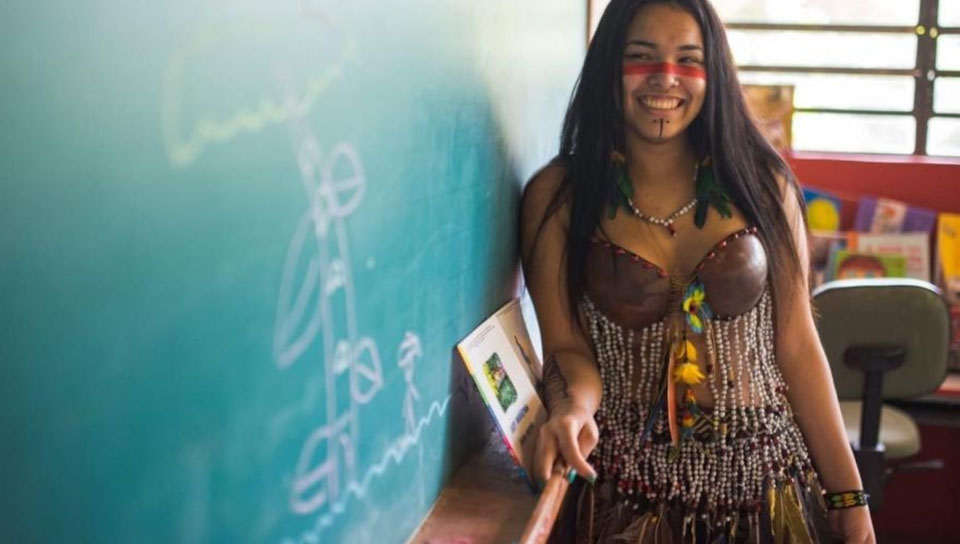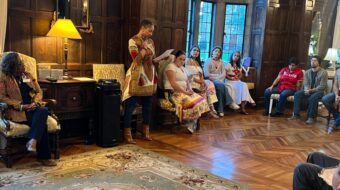
SANTOS, São Paulo (September 27) — Nauany Pótu-Coereguá Gomes Pires, 18, will begin a unique adventure this November. She is going to leave the Indigenous village Tekoá Pakowaty, in Peruíbe on the São Paulo coast, where she was born and raised, to live in Rio Grande, a city in faraway Rio Grande do Sul state, where she will study medicine in a federal university.
Nauany, whose name in the Tupi language means “flower of the dawn,” took the national qualifying examinations in July and came in first among almost 300 Indigenous competitors. This was surprising, because of all the difficulties she had to face just to be able to study.
Her home is located in the rural zone of Peruíbe, in the middle of the Atlantic rain forest, about 15 kilometers from the nearest city, in an area better known as the Village of Bananal.

Although the region has been certified only since the mid-1990s, the Indigenous people of Tupi ethnicity have lived there since before the arrival of the Portuguese. There are existing documents that refer to the seizure of the area by the Order of the Jesuits in 1553 and its restitution 300 years ago.
Nauany’s grandfather, chief Awa Kiririndjú, registered in the notary as João Gomes, was one of those responsible for the people’s reoccupation of their ancestral lands. Nauany considers his work as pajé and defender of the old ways of plant medicine healing as a source of inspiration for her choice of profession:
“Because of my grandfather, it has been my dream ever since I was small to study medicine. In the little time I lived with him before he died, I saw him helping many people with bottles of homemade medicines, herbal baths, teas, and infusions. Plant medicine. That made me want to follow the path of healing people.”
Nauany’s studies started early. At the age of four, she attended daycare classes at the local Indigenous school. At 11, she graduated from elementary school. The classes were organized by her mother, Jacira, and by her uncles, all of whom have teaching degrees from the University of São Paulo (USP).
Her uncle Awa Djipoka, Jacira’s brother, was the first Indigenous teacher in São Paulo State. Before him, no Indigenous teachers had been licensed to teach.
According to Nauany, “He was a pioneer who revolutionized Indigenous instruction. At the time, teachers were not allowed to include traditional teachings, like language, culture, and arts and crafts. He died when I was two and my mother took over where he left off.
“I began school in my mother’s lap. She took me to class with her because there was no one else who would care for me. I tell my friends I was practically born in a classroom.”
Classes in the big city
As there were no middle schools in the countryside, Nauany went to the city when she was 11 years old. The adaptation created unforeseen problems: she really suffered but she learned to improvise and make the best of it.
The first problem was the distance. The nearest school bus stop was a couple of kilometers walk on a dirt road and a two-hour bus ride from Bananal Village. When it rained, the trail turned to mud, making the walk difficult and blocking the buses’ access. They stopped before the asphalt of the highway ended, far from the village. “That is, if the buses weren’t broken,” Nauany says— “there are only two lines that serve our area.”

When this happened, she had to improvise. At best, local residents and friends in the community would give her a lift. Otherwise, the round trip to and from the city would take even longer. After school, Nauany learned that there would be other problems to overcome. Even though the city had electricity and other commodities, there are no libraries or cable internet in that region.
“The signal here is transmitted by antennas. Sometimes it works, sometimes not. This slowed us up somewhat,” she remembers. But nothing proved a greater hindrance for a young Indigenous girl than prejudice.
Bullying: “Wearing beads is ugly”
Nauany liked to dress up for school. It is part of her culture to use colorful, attention-getting earrings and necklaces, often made of feathers, seeds, and things unfamiliar to city-dwellers. It was not long before she was a center of attention, in a negative way.
Her classmates said: “You’re an Indian, why are you wearing clothes?” Or: “If you’re an Indian, why are you using a cell phone?” “Other girls pointed at my adornments and said, ‘Using necklaces is ugly,’” she recalls.
Her teachers did their best to include her and asked her classmates to treat her with respect. But at recess, the provocative remarks intensified.
“I stopped using earrings and necklaces,” Nauany relates. “I began to be ashamed of my roots, of being who I am. I cried often, as I tried to adapt to what I thought they expected me to be, because of their intolerance of other cultures like mine.”
Nauany’s life improved when she began at Etec (Technical School) in Peruíbe, where she took courses in administration. The way she was treated improved, the atmosphere was different. Students and teachers wanted to know more about Indigenous culture.
“The Technical School valued diversity. I made various presentations in which I included cultural and historic details about my people. I started using earrings and necklaces again. I went back to being myself,” she says.

That was when she became part of the “Growing up with Protection” project sponsored by Unicef in partnership with the Public Ministry of Labor, the Public Agenda, and the Camará Calunga Institute, in eight municipalities in the Santos lowlands and the Ribeira Valley.
Their goal was to strengthen the prevention and confrontation of different kinds of violence against children and adolescents through incentivizing education, the inclusion of girls and boys in the job market, and the participation of adolescents and young people in the construction of public policies.
“It was a very intense time. I was graduating from Etec, participating in the UNICEF project, and beginning to study for the medical exam. I began to study as much as fifteen hours a day.” Now, she says, “I am one step away from realizing my dream.”
Preparing for a thousand-kilometer journey
Nauany finished the first semester at Rio Grande University by distance learning, but in November she will leave her village for Rio Grande do Sul. The instruction will be in person and far away. There is a distance of more than 1000 kilometers between the school and the community in which she grew up and has lived until now.
An online fund drive will help her with expenses. But she has to find colleagues willing to room with her or rent a room in a boarding house or a house for students, called a “republic.”
Despite the butterflies in her stomach, she says she is confident because she knows that Nhanderú Nhandedjary (God) watches over and understands all things and will make sure that everything turns out alright.
“This will be my chance to learn all I can about conventional medicine,” she says, with an eye on validating the traditional Indigenous wisdom about medicinal plants.

“I want to be able to interchange natural medicine and science. I am not going to let the old wisdom disappear. I am sure that I will be able to help people even more.”
Nauany’s father, Antonio, 44, is going to ask for several days off from his work so he can travel south with his daughter. “He is coming with me and will help me settle in there. He wants to know that I am going to be okay,” she says.
Father and daughter do not yet know if they will travel to Rio Grande do Sul by car, bus, or plane. But the student confesses that she is a bit apprehensive about the last option. Aside from never having flown before, she is afraid of heights.
She begins to prepare for the voyage in October. She intends to buy suitcases, clothes, and other necessities for life far from home, like accessories and personal hygiene products. And she is sure that she will not leave her necklaces and earrings, the symbols of her ancestry, behind.
“My mother is making some special biojewels for me to take. I hope to find a receptive atmosphere, that I will feel at home there, that I am able to adapt to my new environment, and that I will feel welcomed and embraced. I want to learn as much as I can during this journey.”
Those interested in following Nauany’s journey can reach her by email at potycoeregua@gmail.com.
Maurício Businari is a contributor to the UOL, in Santos, São Paulo
The original article in Portuguese can be viewed here. Translated for People’s World by Peter Lownds.










